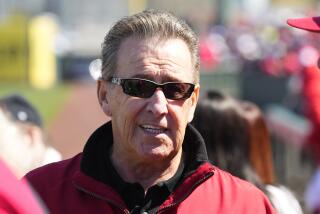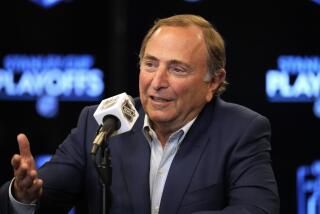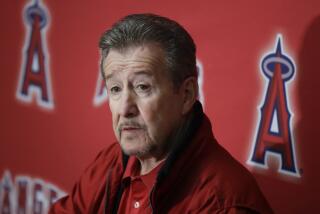Column: The biggest save in St. Louis Blues history happened in 1983, courtesy of Harry Ornest
Reporting from st. louis — The hand-addressed envelopes arrived with no predictable pattern and were always filled with stories Harry Ornest had carefully sliced out of newspapers and critiqued in the margins.
Ornest, a longtime Beverly Hills resident, would sit in his den with a stack of newspapers, a pair of scissors, and a pen, one or more of his four kids nearby, and he’d underline phrases, circle points he disputed, and add his own commentary. He’d mail them to friends, business contacts, and politicians as part of his mission to educate the world.
Some landed in mailboxes of writers at the Los Angeles Times. A description of their contents drew a laugh from Laura Ornest, Harry’s eldest child. “You didn’t get the packages. You just got the small envelopes,” she said.
Harry Ornest, who died in 1998, did many remarkable things in 75 years on this earth. Born in Edmonton to immigrants from Eastern Europe, he became a minor league baseball player, minor league hockey referee and NHL linesman.
Making a fortune on vending machines allowed him to own a minor league baseball team and the Canadian Football League’s Toronto Argonauts and, later, considerable stock in Hollywood Park.
But perhaps closest to his heart was that he rescued the St. Louis Blues from oblivion and a proposed move to Saskatoon, Canada, after owner Ralston Purina abandoned the franchise.
“There was nobody in St. Louis who had enough confidence in that team to put up the money to buy the team,” said Laura Ornest, a former KNX reporter who lives in Pacific Palisades. “The Blues would not be in the Stanley Cup Final if Harry hadn’t saved the team in 1983, which is pretty incredible.”
The Blues are making their first appearance in the Final since 1970, winning raves for their resilience and ruggedness. They’re tied with the Boston Bruins at 1-1, with Game 3 to be played Saturday at Enterprise Center.
“The city is going crazy,” Bob Plager, a member of the original 1967-68 team, said after the Blues’ 3-2 overtime victory at Boston on Wednesday. “There are still fans and a lot of people from the first years in St. Louis there that go to the games that I talk to, and we can do something for them.”
Their current success makes it easy to forget how close they came to folding.
One of six teams added to the NHL in 1967, the Blues had fallen on hard times by the early 1980s and were stuck in the dilapidated Checkerdome, named for Ralston Purina’s checkerboard logo.
When the company decided to cut its losses and sell the team, no one wanted them except Canadian businessman Bill Hunter, who planned to move them to Saskatoon. When the NHL said no, Ralston Purina essentially turned the keys to the team back to the league.
Enter Ornest, who had read about the Blues’ predicament. He had a comfortable life in Southern California and didn’t need the headache of reviving a franchise, but the allure of owning a big league team was powerful, especially after his previous efforts to buy the Seattle Mariners and other clubs had failed.
“We grew up listening to dad on the phone trying to convince his wealthier friends to buy various teams over the years and it didn’t happen,” Laura Ornest said.
He put his proceeds from his sale of the triple-A baseball Vancouver Canadians toward purchasing the Blues, paying $3 million in cash plus $9 million in unsecured notes for the team and paying $5 million for the arena. He also raised $3 million in operating expenses from St. Louis investors. Laura, a sportscaster for CBC in Vancouver, got to announce the acquisition on the air.
“He bought the teams no one else wanted,” said Mike Ornest, the third child of Harry and Ruth Ornest and a former minor league baseball player. “I didn’t think it was crazy because his lifelong dream was to own a major league franchise.”
Harry Ornest, parsimonious enough to type his own letters, brought his family to St. Louis to run the operation. Laura had her broadcasting career, but Mike was appointed president of the arena and vice president of the hockey team, and another daughter, Cindy, was a vice president of the arena company. Both were involved with the in-house ticketing company and advertising agency Harry created for the busy arena.
A fourth child, Maury, also joined the family business. “He wanted to save money and people talked about it being — what’s a nice way of putting it besides bare bones? — economical and efficient,” Laura said of her father. “I’d imagine he worked 16 hours a day. He was also the kind of owner, I don’t know if other owners are like this, but if he saw a piece of trash in the concourse of the arena he’d pick it up.”
Mike remembers him as a tireless promoter. “He would miss half a hockey game if it meant speaking to a group of Boy Scouts or at a church gathering or whatever,” Mike said. “If there was somewhere they wanted him, he would do it.”
Ornest earned a honeymoon period because he upgraded the building — which reverted to being called the St. Louis Arena — and hired former Montreal Canadiens executive Ron Caron to run the team. Caron hired Jacques Demers and the Blues became competitive but he didn’t have deep pockets. Many star players were traded.
Mike Ornest said some moves were strategic and not financial, such as dealing Joey Mullen for beefy Eddie Beers and Gino Cavallini after the Blues had been manhandled in the playoffs, but Harry was villified. “He rode in on a white horse and was god for a while. Then he started doing all of those things and ticked everybody off,” Plager told author Jeremy Rutherford in the book “100 Things Blues Fans Should Know and Do Before They Die.”
Ever the canny businessman, Ornest sold the Blues to Michael Shanahan for $19 million in 1986 and sold the arena to the city of St. Louis for $15 million. “His selling was bittersweet,” Mike said, recalling that before the sale his father had secured the 1988 All-Star game for St. Louis but wasn’t invited to attend.
Ornest bought the Argonauts in 1988 and later sold them to a group headed by Bruce McNall, Wayne Gretzky and John Candy. He was vice chairman of Hollywood Park when he died after a short illness; in the year before that, he and then-Hollywood Park chairman R.D. Hubbard tried to buy the Clippers from Donald Sterling, build an arena at Hollywood Park for them, and hire Jerry West as president. The man was a visionary.
The three surviving Ornest siblings — Maury died in 2018 — have enjoyed the Blues’ run to the Cup Final and the memories it has stirred. “I was so proud of my dad with his experience that he brought into it and how he knew so much about everything on so many levels,” Cindy said. “He afforded me so many opportunities.”
Mike has some memorabilia, including a Brian Sutter road jersey and some photos. Laura said her son Harrison Ornest-Leslie recently asked her to send an old Blues jersey to him at college. She also has thousands of Harry’s newspaper clippings and a soft spot for the Blues.
“I have this image of dad and Maury watching the games. I don’t know if they’re in an owner’s box. Maybe. But they’re together and my mother’s there too, but she’d be talking to somebody or putting on her lipstick,” Laura said. “I would imagine that dad’s sitting up there watching, and he would want these Blues to go all the way.”
Follow Helene Elliott on Twitter @helenenothelen
More to Read
Go beyond the scoreboard
Get the latest on L.A.'s teams in the daily Sports Report newsletter.
You may occasionally receive promotional content from the Los Angeles Times.






